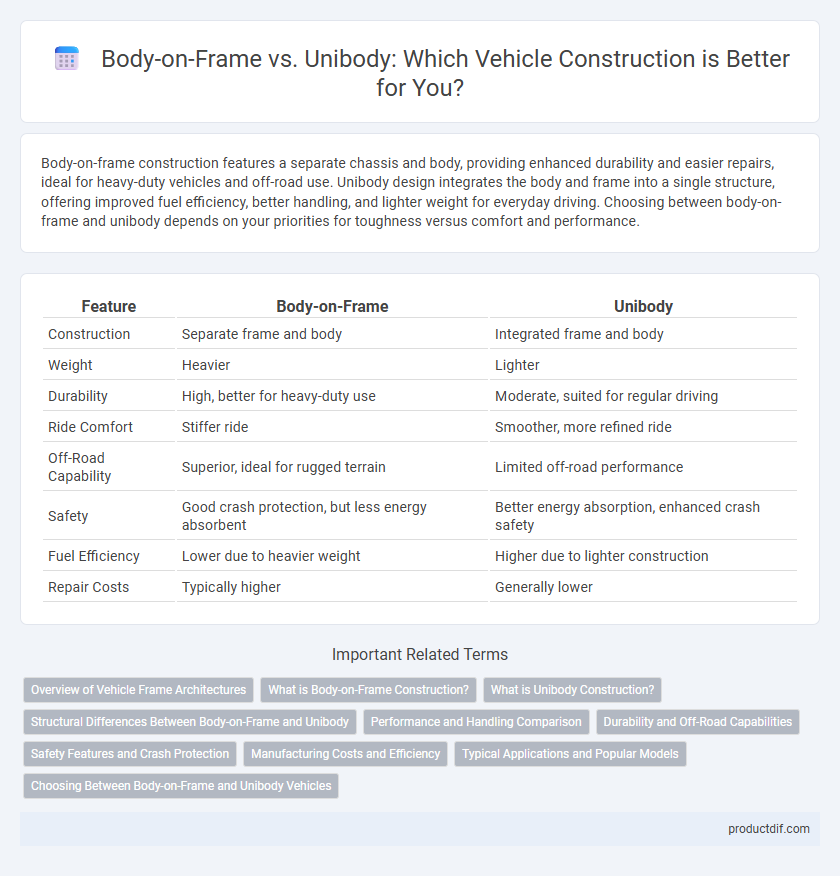Body-on-frame construction features a separate chassis and body, providing enhanced durability and easier repairs, ideal for heavy-duty vehicles and off-road use. Unibody design integrates the body and frame into a single structure, offering improved fuel efficiency, better handling, and lighter weight for everyday driving. Choosing between body-on-frame and unibody depends on your priorities for toughness versus comfort and performance.
Table of Comparison
| Feature | Body-on-Frame | Unibody |
|---|---|---|
| Construction | Separate frame and body | Integrated frame and body |
| Weight | Heavier | Lighter |
| Durability | High, better for heavy-duty use | Moderate, suited for regular driving |
| Ride Comfort | Stiffer ride | Smoother, more refined ride |
| Off-Road Capability | Superior, ideal for rugged terrain | Limited off-road performance |
| Safety | Good crash protection, but less energy absorbent | Better energy absorption, enhanced crash safety |
| Fuel Efficiency | Lower due to heavier weight | Higher due to lighter construction |
| Repair Costs | Typically higher | Generally lower |
Overview of Vehicle Frame Architectures
Body-on-frame architecture features a separate, rigid frame that supports the vehicle's body, providing enhanced durability and off-road capability, commonly used in trucks and SUVs. Unibody construction integrates the body and frame into a single, lightweight structure, improving fuel efficiency, handling, and safety, favored in passenger cars and crossovers. These fundamental differences influence vehicle performance, repair costs, and design flexibility across various automotive segments.
What is Body-on-Frame Construction?
Body-on-frame construction features a separate metal frame that supports the vehicle's engine and drivetrain, while the body is mounted independently on top. This design enhances durability and off-road capability, making it common in trucks and SUVs. The rigid frame provides superior strength for towing and heavy-duty applications compared to unibody construction.
What is Unibody Construction?
Unibody construction integrates the vehicle's body and frame into a single, cohesive structure, enhancing rigidity and reducing overall weight compared to traditional body-on-frame designs. This construction method improves fuel efficiency and handling by distributing impact forces more evenly in the event of a collision. Most modern passenger cars and crossover SUVs utilize unibody construction for its balance of strength and lightweight performance.
Structural Differences Between Body-on-Frame and Unibody
Body-on-frame construction features a separate steel frame that supports the vehicle's mechanical components and a detachable body, providing increased durability and ease of repair. Unibody design integrates the body and frame into a single cohesive structure, enhancing rigidity and reducing overall vehicle weight for improved fuel efficiency and handling. Structural differences significantly impact vehicle performance, with body-on-frame favored for heavy-duty trucks and off-road vehicles, while unibody is common in passenger cars for better crash protection and ride comfort.
Performance and Handling Comparison
Body-on-frame vehicles excel in durability and off-road performance due to their rigid chassis design, providing superior towing and load-carrying capabilities. Unibody construction offers enhanced handling and ride comfort by integrating the body and frame into a single cohesive structure, reducing weight and improving vehicle agility. Performance differences highlight that body-on-frame suits heavy-duty tasks, while unibody delivers better on-road dynamics and fuel efficiency.
Durability and Off-Road Capabilities
Body-on-frame construction offers superior durability and enhanced off-road capabilities due to its separate chassis and body design, allowing for better absorption of rough terrain impacts. Unibody vehicles integrate the body and frame into a single structure, which improves overall vehicle rigidity and weight savings but generally sacrifices some off-road toughness. For rugged conditions and heavy-duty use, body-on-frame remains the preferred choice among off-road enthusiasts and commercial vehicles.
Safety Features and Crash Protection
Body-on-frame vehicles typically offer enhanced durability and superior protection in high-impact collisions due to their rigid frame structure, which absorbs and disperses crash forces effectively. Unibody designs integrate the body and frame into a single structure, optimizing crumple zones and improving energy absorption to reduce occupant injuries. Advanced safety features like reinforced side-impact beams and strategically placed airbags are more efficiently incorporated into unibody vehicles, enhancing overall crash protection performance.
Manufacturing Costs and Efficiency
Body-on-frame construction typically incurs higher manufacturing costs due to the need for separate chassis and body assemblies, leading to increased material usage and labor. Unibody design integrates the body and frame into a single structure, enabling more streamlined production processes and reduced material expenses. This efficiency in unibody manufacturing results in lower overall costs, making it preferable for mass-produced passenger vehicles.
Typical Applications and Popular Models
Body-on-frame construction is commonly used in trucks, SUVs, and off-road vehicles due to its durability and ease of repair, with popular models including the Ford F-150, Toyota Tacoma, and Jeep Wrangler. Unibody design is favored in passenger cars and crossover SUVs for improved fuel efficiency and handling, exemplified by vehicles such as the Honda Accord, Toyota Camry, and Subaru Outback. Each construction type aligns with specific vehicle applications, balancing strength and weight according to intended use and driving conditions.
Choosing Between Body-on-Frame and Unibody Vehicles
Choosing between body-on-frame and unibody vehicles depends on intended use, as body-on-frame excels in off-road durability and towing capacity, making it ideal for trucks and SUVs designed for heavy-duty tasks. Unibody construction offers better fuel efficiency, handling, and safety in passenger cars and crossover SUVs due to its lighter weight and integrated frame design. Evaluating factors such as payload requirements, ride comfort, and typical driving conditions ensures the optimal vehicle structure aligns with performance and lifestyle needs.
Body-on-Frame vs Unibody Infographic

 productdif.com
productdif.com